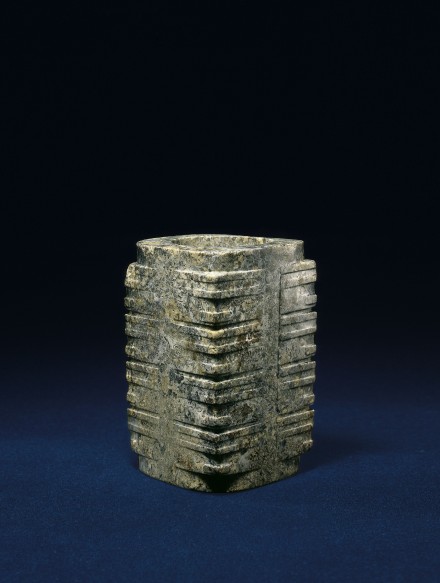J.J. Lally & Co., Oriental Art / New York City, New York
Menu
5.
A NEOLITHIC MOTTLED GREEN AND TAN JADE CONG
Liangzhu Culture, circa 3300 – 2250 B.C.
hollowed as a cylinder, the slightly tapered flat sides with square projecting panels angled across four corners and divided into four tiers, the wide apertures at either end enclosed by short plain collars, the repeating panels each carved with a rudimentary stylized mask comprised of twin parallel ridges above small round incised ‘eyes’ and a short raised bar for the ‘nose’, the panels separated by deep grooves cut across the angle to end at the plain vertical band down the center of each side, the interior of the thick walls plain and polished, the dark green jade mottled with tan-brown and pale grayish-white, showing a weathered surface.
Height 4 3⁄4 inches (12 cm)
A Liangzhu jade cong of similar form, with five tiers of corner-panels similarly carved with stylized masks, excavated from tomb no. 1 at the Shedunmiao site, Haining, Zhejiang province and currently in the collection of the Haining Museum is illustrated by Gu (ed.) in Zhongguo chutu yuqi quanji (Complete Collection of Jades Unearthed in China), Vol. 8, Zhejiang, Beijing, 2005, p. 32.
Another Liangzhu jade cong carved with five tiers of similarly stylized masks, unearthed at Meijiali, Zhejiang province is illustrated in the catalogue of the special exhibition at the Arthur M. Sackler Museum of Art and Archaeology at Beijing University by Qin and Fang (eds.), Quanli yu xinyang: Liangzhu yizhi qun kaogu tezhan (Power in Things: New Perspectives on Liangzhu), Beijing, 2015, pp. 211-213, no. II-2-1, with description on p. 385. Compare also the similarly carved Liangzhu jade cong with six tiers of masks unearthed from Wujiafu, Zhejiang province, now in the collection of the Yuhang Museum in Hangzhou, also illustrated by Qin and Fang (eds.), op. cit., pp. 352-353, III-2-12, with description on p. 431.
新石器時代 良渚玉琮 高 12 厘米
5.
A NEOLITHIC MOTTLED GREEN AND TAN JADE CONG
Liangzhu Culture, circa 3300 – 2250 B.C.
Height 4 3⁄4 inches (12 cm)